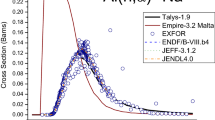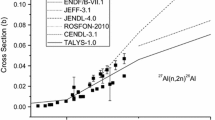Abstract
Environmental concerns associated with fossil fuels are creating increased interest in alternative non-fossil energy sources. Nuclear fusion can be one of the most attractive sources of energy from the viewpoint of safety and minimal environmental impact. When considered in all energy systems, the requirements for performance of structural materials in a fusion reactor first wall, blanket or diverter, are arguably more demanding or difficult than for other energy system. The development of fusion materials for the safety of fusion power systems and understanding nuclear properties is important. In this paper, ground state properties for some structural fusion materials as 27Al, 51V, 52Cr, 55Mn, and 56Fe are investigated using Skyrme–Hartree–Fock method. The obtained results have been discussed and compared with the available experimental data.
Similar content being viewed by others
Avoid common mistakes on your manuscript.
Introduction
The world energy demand is increasing day by day. To meet the demand, the nuclear fusion with safety, environmentally acceptability and economic is the best suited. The success of fusion power system is dependent on performance of the first wall, blanket or divertor systems [1]. The performance of structural materials for fusion power systems and understanding nuclear properties is important. Therefore, ground state properties for some structural fusion materials as 27Al, 51V, 52Cr, 55Mn, and 56Fe are investigated using Skyrme–Hartree–Fock method (SHF) in this study.
We investigate the results on the root-mean-square (rms) proton, neutron and charge density radii, binding energies per particle and the proton neutron and charge density distributions of some structural fusion materials as 27Al, 51V, 52Cr, 55Mn, and 56Fe using the SHF calculations with the new SLy4, SLy5, SLy6, and SLy7 force parameters. These Skyrme force parameters were developed by Chabanat et al. [2, 3]. Chabanat et al. have adjusted these parameters to the properties of the symmetric infinite nuclear matter, with an additional constraint on the low and high density neutron equation of state. These parameters values and the other Skyrme force parameters can be found from the references [2–9]. The sets of these parameters are firstly used for the above nuclei in the present paper. The calculated results are compared with the available experimental values [10, 11]. The aim of this study is to investigate charge, neutron and proton distributions for some structural fusion materials with new Skyrme parameters and contribute to understanding ground state properties for these structural fusion materials.
Theoretical Framework
The effective interaction proposed by Skyrme was designed for Hartree–Fock calculations of nuclei [12]. It basically consists of a two-body term which is momentum-dependent, and a zero-range three-body term. Skyrme interactions’ analytical simplicity allows a determination of their parameters, which incorporates basic physical properties such as the saturation of infinite nuclear matter, binding energies of some nuclei, and other simple nuclear experimental information. The SHF model is a standard method and all the formulations can be found in Refs. [4, 9, 13]. The BCS (Bardeen–Cooper–Schrieffer) formalism for pairing effects has been used in the present calculation.
The neutron or proton densities in the SHF method are given by
where \( \psi_{\beta } \) is the single-particle wave function of the state β, the occupation probability of the state β is denoted by \( w_{\beta } \). The nuclear charge density is obtained from the charge form factor (\( F_{c} (k) \)) by the inverse Fourier–Bessel transform
where j0 is the spherical Bessel function of the zeroth order. The rms charge, neutron and proton radii can be evaluated from these densities (Equations (1) and (2));
where a represent neutron, proton and charge.
Results and Discussions
In this study, the rms charge, neutron and proton density radii, binding energies per particle and charge, neutron and proton density distributions are calculated using the Hartree–Fock method with Skyrme forces for some structural fusion materials as the 27Al, 51V, 52Cr, 55Mn, and 56Fe and compared with experimental data. These calculations with SLy4, SLy5, SLy6, and SLy7 Skyrme force parameters have been done with the HARTREE–FOCK code [14]. The calculated the rms charge, neutron and proton density radii with SLy4, SLy5, SLy6, and SLy7 Skyrme force parameters are presented in Tables 1, 2 and 3.
The values of the rms charge, neutron and proton density radii for SLy4 parameters are bigger than those of SLy5, SLy6, and SLy7 Skyrme force parameters for each nucleus. The rms neutron density radii are increased from 2.9714 (for 27Al) to 3.7052 fm (for 56Fe) with the increasing of neutron number in Table 1. The obtained rms charge density radii for all parameter sets are higher than those of the rms proton density radii for each nucleus in Tables 2 and 3. Also, the rms charge density radii of 27Al, 51V and 52Cr for SLy7 sets of parameters are closer to experimental data than those of SLy4, SLy5, and SLy6 interactions. But, the rms charge radii of 55Mn and 56Fe for SLy6 parameters are closer to experimental data than those of other interactions.
The obtained binding energies per particle using Skyrme–Hartree–Fock Model are presented in Table 4. According to these results, binding energies of 27Al, 52Cr and 56Fe for SLy6 sets of parameters are closer to experimental data than those of SLy4, SLy5, and SLy7 interactions. Furthermore, binding energies of 51V for SLy5 and 55Mn for SLy7 parameters are closer to experimental data than those of other interactions.
The calculated proton, neutron and charge density distributions using SLy4, SLy5, SLy6, and SLy7 Skyrme force parameters have been plotted in Figs. 1, 2. The obtained neutron and proton densities with SLy4, SLy5, SLy6, and SLy7 Skyrme force parameters for 27Al, 51V, 52Cr, 55Mn, and 56Fe nuclei are approximately same. The neutron densities for selected nuclei at the center (r = 0) have increased from ∼0.07 (for 27Al) to ∼0.09 fm−3 (for 56Fe). The neutron distributions of 55Mn and 56Fe nuclei are smoother than those of other selected nuclei in Fig. 1. The proton density distributions from 27Al to 56Fe at the center (r = 0) have increased with the nucleon number increases. But, these distributions at about 2 fm are decreased.
At the center (r = 0), the charge density distributions of 27Al nucleus are lower than those of other selected nuclei in Fig. 2. The charge density of 27Al nucleus for Sly6 parameters is different from those of Sly4, Sly5 and SLy7 Skyrme force parameters. But, the obtained charge densities with SLy4, SLy5, SLy6, and SLy7 Skyrme force parameters for 51V, 52Cr, 55Mn, and 56Fe nuclei are approximately same. The charge distributions with Sly4, Sly5 and SLy7 Skyrme force parameters of 27Al nucleus at about 2 fm have maximum value. Also, the calculated charge densities of 51V, 52Cr, 55Mn, and 56Fe nuclei at the center have very similar values.
Conclusion
The charge, proton and neutron densities, binding energies per particle and the rms charge, proton and neutron radii have been calculated for 27Al, 51V, 52Cr, 55Mn, and 56Fe nuclei by using the Hartree–Fock method with an effective Skyrme force with SLy4, SLy5, SLy6 and SLy7 parameters. The rms proton and neutron densities radii of some structure fusion material for Sly4 sets of parameters are bigger than those of SLy5, SLy6 and SLy7 parameters. The rms charge radii of SLy6 and SLy7 parameters accord well experimental data. The binding energies per particle of SLy5, SLy6 and SLy7 are also agreement with experimental ones. The neutron density distributions of structural fusion materials for SLy4, SLy5, SLy6, and SLy7 Skyrme force parameters have approximately similar values. This situation also applies to proton and charge densities, except for the charge density of 27Al nucleus. The charge density of 27Al nucleus for Sly6 parameters is different from those of Sly4, Sly5 and SLy7 Skyrme force parameters. Therefore, Sly6 parameters may be not appropriate for the charge density of 27Al nucleus. These results can be contributed to understanding ground state properties for these structural fusion materials.
References
E.E. Bloom, J. Nucl. Mat. 253–268, 7–17 (1998)
E. Chabanat et al., Nucl. Phys. A 627, 710–746 (1997)
E. Chabanat et al., Nucl. Phys. A 635, 231 (1998)
P. Ring, P. Schuck, The Nuclear Many Body Problem (Springer, Berlin, Heidelberg, 1980)
N.V. Giai, H. Sagawa, Physics Lett. B 106(5), 379–382 (1981)
E. Tel et al., Ann. Nucl. Energy 35, 220–227 (2008)
E. Tel et al., Commun. Theor. Phys. 49, 696–702 (2008)
L.X. Ge et al., Nucl. Phys. A 459(1), 77–92 (1986)
L.G. Qiang, J. Phys, G. Nucl. Part. Phys. 17, 1–34 (1991)
I. Angeli, Nucl. Data Tables 87, 185–206 (2004)
http://cdfe.sinp.msu.ru/services/index.en.html, Centre for Photonuclear Experiments Data, Lomonosov Moscow State University, Skobeltsyn Institute of Nuclear Physics, (2009)
T.H.R. Skyrme, Nucl. Phys. 9, 615–634 (1959)
D. Vautherin, D.M. Brink, Phys. Rev. C 5(3), 626–647 (1972)
P.G. Reinhard, H. Flocard, Nucl. Phys. A 584(3), 467–488 (1995)
Author information
Authors and Affiliations
Corresponding author
Rights and permissions
About this article
Cite this article
Aytekin, H., Tel, E., Baldik, R. et al. An Investigation for Ground State Features of Some Structural Fusion Materials. J Fusion Energ 30, 21–25 (2011). https://doi.org/10.1007/s10894-010-9326-7
Published:
Issue Date:
DOI: https://doi.org/10.1007/s10894-010-9326-7






